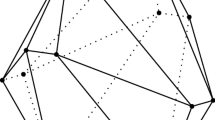Abstract
Some of the main notions and theorems about blocking pairs of polyhedra and antiblocking pairs of polyhedra are described. The two geometric duality theories conform in many respects, but there are certain important differences. Applications to various combinatorial extremum problems are discussed, and some classes of blocking and anti-blocking pairs that have been explicitly determined are mentioned.
Similar content being viewed by others
References
C. Berge, “Färbung von Graphen, deren sämtliche bzw deren ungerade Kreise starr sind (Zusammenfassung),”Wiss. Z. Martin-Luther-Univ. Halle Wittenberg Math. Natur. Reihe (1961) 114.
C. Berge, “Some classes of perfect graphs,” in:Graph theory and theoretical physics, Ed. F. Harary (Academic Press, New York, 1967).
C. Berge, “The rank of a family of sets and some applications to graph theory,” in:Recent progress in combinatorics, Ed. W.T. Tutte (Academic Press, New York, 1969).
R.P. Dilworth, “A decomposition theorem for partially ordered sets,”Annals of Mathematics 51 (1950) 161.
R.J. Duffin, “The extremal length of a network,”J. Math. Anal. Appl. 5 (1962) 200.
J. Edmonds, “Paths, trees and flowers,”Canadian Journal of Mathematics 17 (1965) 499.
J. Edmonds, “Maximum matching and a polyhedron with (0, 1)-vertices,”J. Research National Bureau of Standards 69B (1965) 125.
J. Edmonds, “Minimum partition of a matroid into independent sets,”J. Research National Bureau of Standards 69B (1965) 67.
J. Edmonds, “Lehman s switching game and a theorem of Tutte and Nash-Williams,”J. Research National Bureau of Standards 69B (1965) 73.
J. Edmonds, “Matroids and the greedy algorithm” (lecture, Princeton, August 1967).
J. Edmonds, “Optimum branchings,” in:Mathematics of the decision sciences, Lectures in applied mathematics, Eds. G.B. Dantzig and A.F. Veinott, Jr., Vol. 11 (American Mathematical Society, 1968) p. 346.
J. Edmonds, “Submodular functions, matroids, and certain polyhedra,” in:Combinatorial structures and their applications, Eds. R. Guy, H. Hanani, N. Sauer, J. Schonheim (Gordon and Breach, 1970) p. 69.
J. Edmonds, “Edge-disjoint branchings” (to appear).
J. Edmonds and D.R. Fulkerson, “Bottleneck extrema,”J. Combinational Theory 8 (1970) 299.
L.R. Ford, Jr., and D.R. Fulkerson,Flows in networks (Princeton University Press, 1962).
D.R. Fulkerson, “The maximum number of disjoint permutations contained in a matrix of zeros and ones,”Canadian Journal of Mathematics 16 (1964) 729.
D.R. Fulkerson, “Networks, frames, blocking systems,” in:Mathematics of the decision sciences, lectures in applied mathematics, Eds. G.B. Dantzig and A.F. Veinott, Jr., (American Mathematical Society, 1968) p. 303.
D.R. Fulkerson, “Blocking polyhedra,” in:Graph theory and its applications, Ed. B. Harris (Academic Press, 1970) p. 93.
D.R. Fulkerson, “Anti-blocking polyhedra,” to appear inJ. Combinational Theory.
D.R. Fulkerson, “Disjoint common partial transversals of two families of sets,” in:Studies in pure mathematics, Ed. L. Mirsky (Academic Press, 1971) p. 107.
T.C. Hu, “Multi-commodity network flows,”Operations Research 11 (1963) 344.
E.L. Lawler, “Optimal matroid intersections,” in:Combinatorial structures and their applications, Eds. R. Guy, H. Hanini, N. Sauer, J. Schonheim (Gordon and Braech, 1970) p. 233.
A. Lehman, “On the width length inequality,” Mimeo. (1965).
J.T. Robacker,Min-max theorems on shortest chains and disjunct cuts of a network (The Rand Corporation, RM-1660-PR, 1956).
W.T. Tutte, “On the problem of decomposing a graph inton connected factors.”J. London Mathematical Society 36 (1961) 221.
W.T. Tutte, “Lectures on matroids,”J. Research National Bureau of Standards 69B (1965) 1.
Author information
Authors and Affiliations
Rights and permissions
About this article
Cite this article
Fulkerson, D.R. Blocking and anti-blocking pairs of polyhedra. Mathematical Programming 1, 168–194 (1971). https://doi.org/10.1007/BF01584085
Received:
Revised:
Issue Date:
DOI: https://doi.org/10.1007/BF01584085




